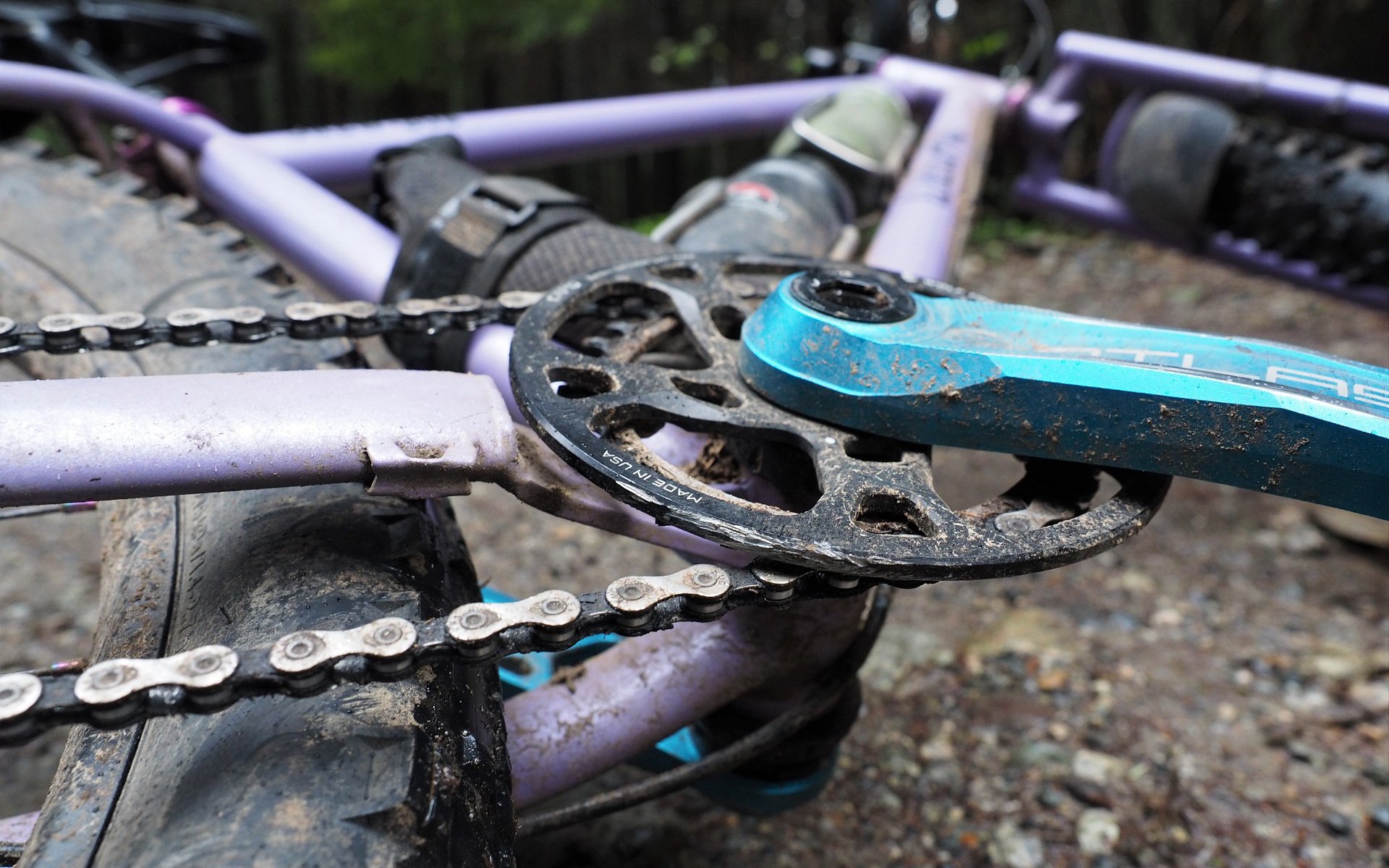
REVIEW | EDITORIAL
Coming Back To Bash Rings (With Wolf Tooth CAMO)
Hold The Tacos
Bikes are getting lower, the average rider is moving faster, and many folks are hitting the trails on aluminum chainrings that are scraping the 100 USD mark. Not to mention the cost of the 12-speed chain that's actually the first point of contact with any vicious rock or other impediment. At the same time, chainrings are growing in size to better complement the manhole covers we're now using for granny-cogs, and riders are putting 165mm cranks on their XXL frames to avoid pedal strikes. All this together means chainring contact is once again becoming a common occurrence. It's a recipe for long walks out of the woods for aggressive riders and premature investments in new drivetrain parts for everyone.
And yet the ISCG 'Taco-style' bash guard is free-falling out of fashion. Is it all the stories of riders breaking their frames due to hard Taco-ings? Is it the way they get hung up on the trail where a crank-mounted bash ring rolls up and over? Maybe it comes down to broken Taco-style bash guards that didn't get replaced? In any event, I didn't bother with having ISCG tabs welded on either of my custom frames and I see fewer and fewer mountain bikers using them on the trails despite ever-increasing reasons to protect drivetrains.

The trails are the same, and the static 65mm BB-drop on my Walt V2 isn't that low but I've had a few very hard chainring knocks in the last year.
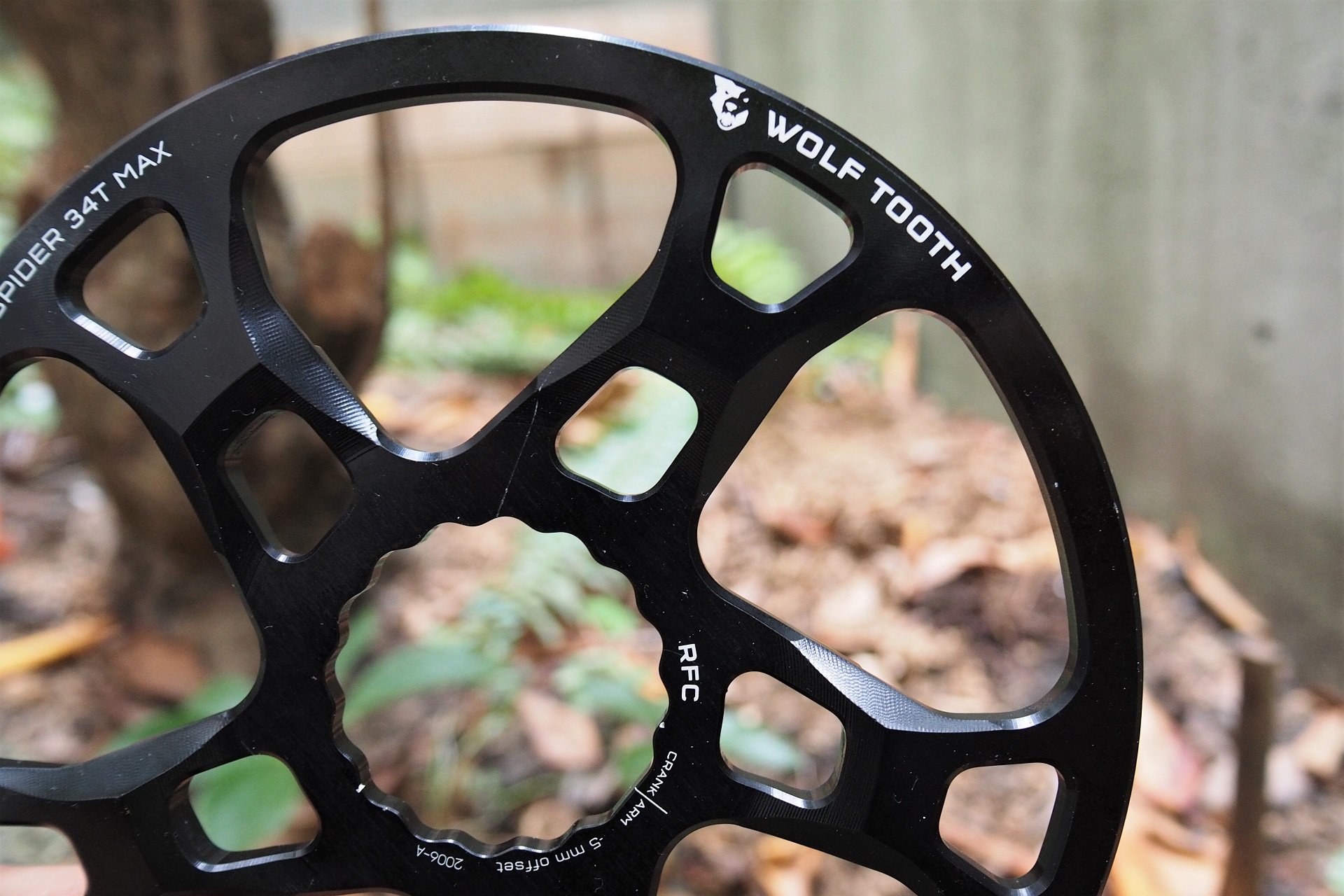
The Wolf Tooth CAMO BashSpider. This one is for Race Face Cinch. I transferred over the stainless steel 30t oval ring I've been running for ages.
Recently, I've been using Wolf Tooth's new CAMO bash ring with the 30t stainless steel narrow-wide chainring I've been running on my single speed for a couple of years. It combines their 5-bolt chainring system that I've been using for three years now, and it's showing plenty of raw aluminum where the anodizing has been hammered. I appreciate this proof of concept almost as much as the system itself. We've come full circle and I expect to be talking about Race Face, SRAM, and other brands' creative crank-mounted bash solutions in short order.
A week before Wolf Tooth released their CAMO bash ring I had a nearly-catastrophic failure of a standard CAMO spider. Now, I've hit my chainring on plenty of things and if it was in any way a 'JRA moment' I wouldn't have said that the spider owed me anything. I would have absolutely accepted it as fatigue. However, in this case, I was trying to chase Naked-Nick - a former XC racer for Naked Bikes - down some low-angle Shore-XC when I smoked my chainwheel so hard that my bike did an impression of Ryan Leech's best bunny hop. I came down pedaling but my bike had suddenly started creaking with every stroke. A very quick inspection didn't yield any obvious issues so away I went, ignoring the creaking, and riding for another hour or so.
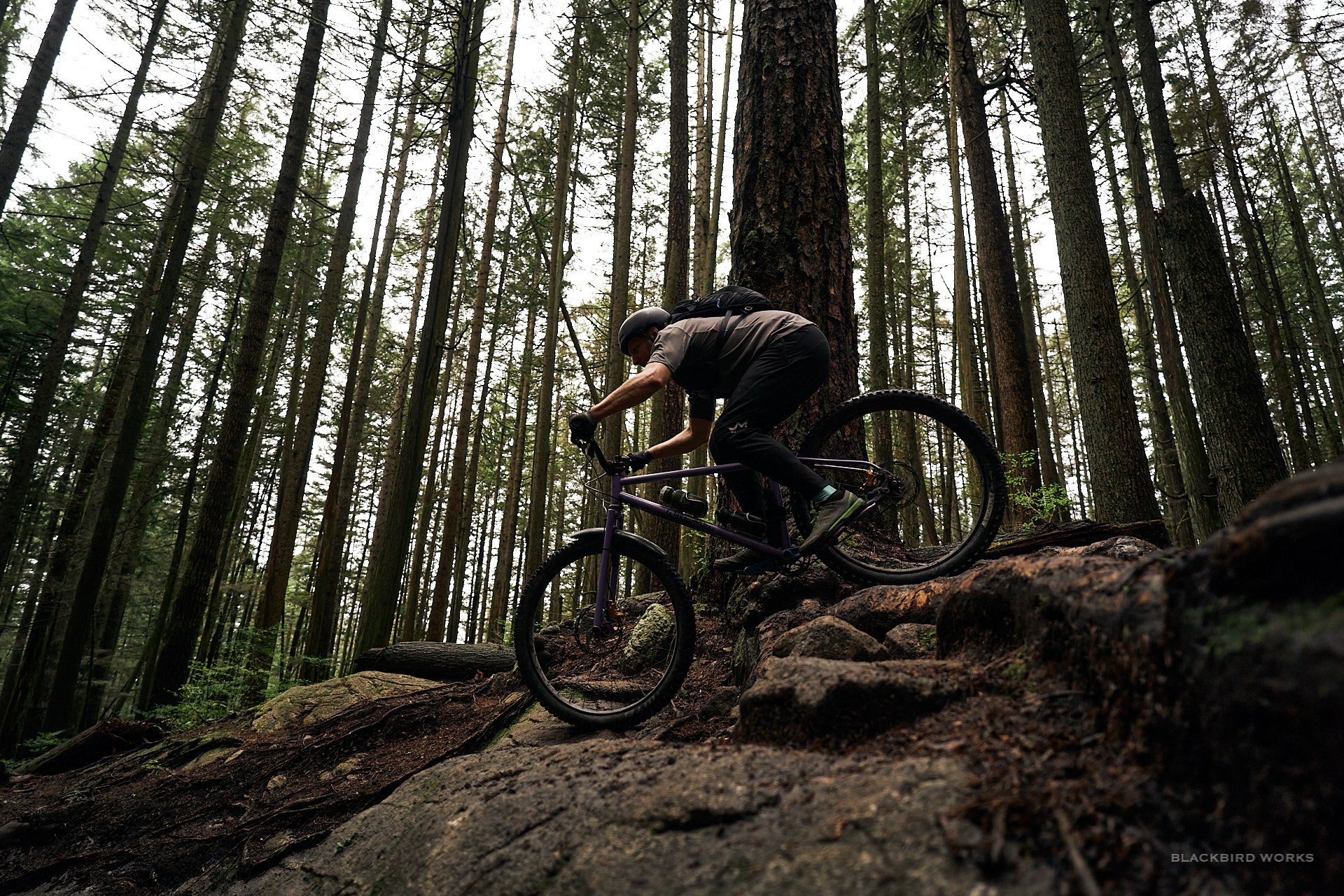
One of the biggest blemishes in my bash ring came from riding Dale's with Deniz. The nice thing with the classic crank-mounted bash is just cranking up, over, and onwards. Photo: Deniz Merdano
A more thorough inspection at home shined a light on the issue. The two spider arms opposite the impact zone had sheered right off the spider. Amazingly, even after another hour of pedaling, my stainless steel ring was perfectly true and still exactly as oval as I'd expect it to be. I was riding my single speed so there's no rear derailleur cage to rotate forward and give the chain slack. It was one of the hardest ring-to-rock contacts I've had but also a rare situation where running #1FG probably was harder on my drivetrain compared to 12-speeds and brutal chainlines.
In any event, the death of my beautiful gold spider provided an opportunity to test something very old that's brand new again. I was running my CAMO setup on a pair of FSA cranks, which use the Cannondale-FSA direct mount standard, but Wolf Tooth is offering the CAMO Bashspider for SRAM, RaceFace, and Shimano direct mount. That meant cracking a couple of beers, pulling my trusty blue Atlas cranks off the shelf, and rebuilding a very thoroughly abused King BSA 30mm BB. And now we are rolling in style.
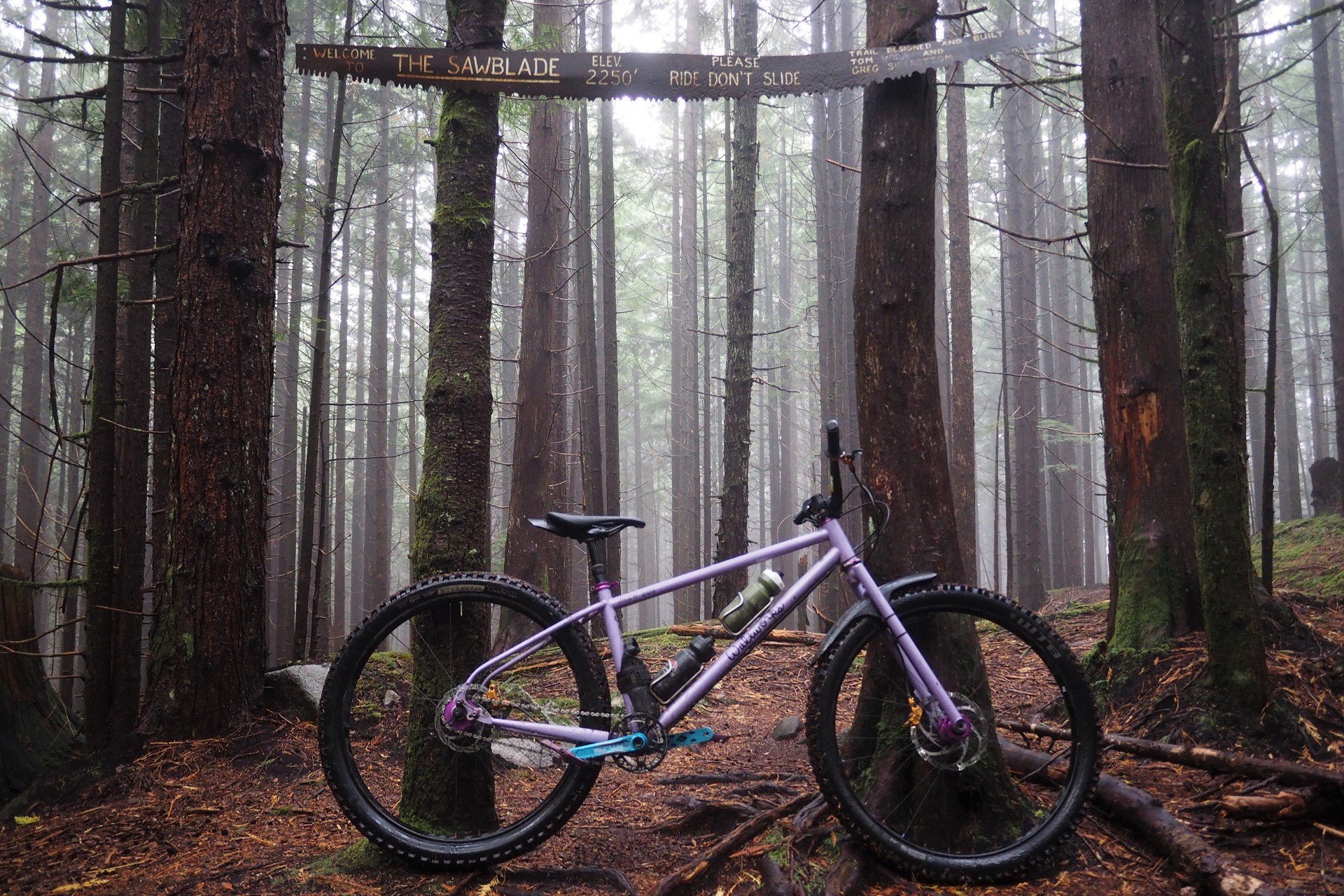
Maybe it's because I like old trails, or am riding a long bike, but I contact my chainwheel, and now the bash ring, fairly frequently on rides.
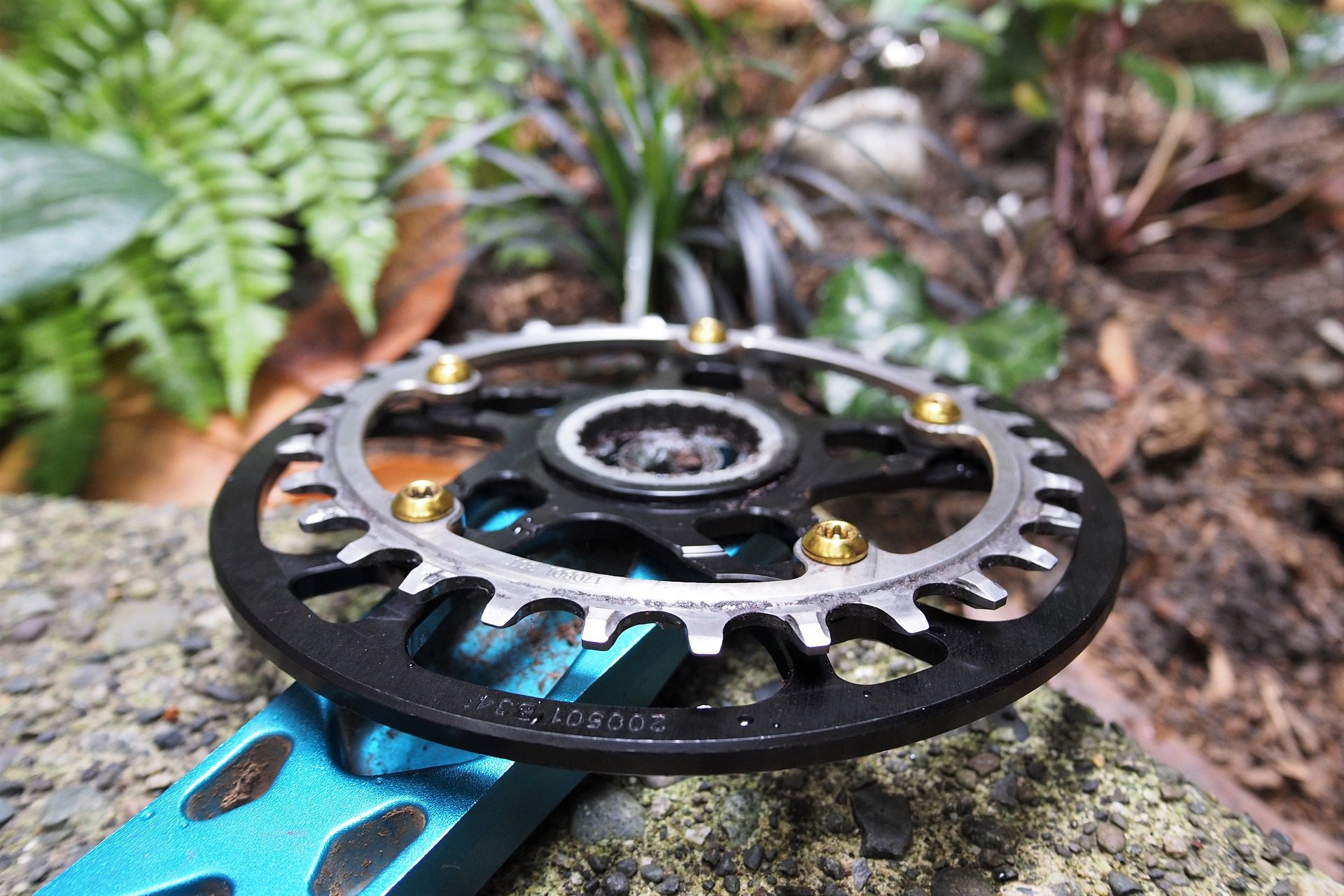
Wolf Tooth BashSpider. The bash guard attaches to the crank and then acts as the spider for the CAMO 5-bolt chainring.
On the OE chainring front, both SRAM's Eagle chainrings and Shimano's new direct-mount rings use fairly beefy construction. With less machining and some threaded holes, both companies could likely offer an inverted version of the CAMO BashSpider where the bash guard bolts onto the chainring instead of the chainring bolting on to the bash guard. This isn't a new idea however and street BMX Bikes have been using direct-mount rings with bash plates bolted on to them forever. I could see Race Face doing a Cinch bash-and-ring in the style of White Industries' one-piece ENO Bashring setup.
My experience running a bash guard again has been loaded with 'well, duh' moments to the extent that I'm at a loss to explain how I ever answered the siren's call of direct-mount 4/104 cranksets to begin with. I much prefer the beauty and function of CAMO's five steel T-25 bolts over a classic chainring bolt arrangement but I'm also positive I'd prefer function over form with bash guards on all my bikes.
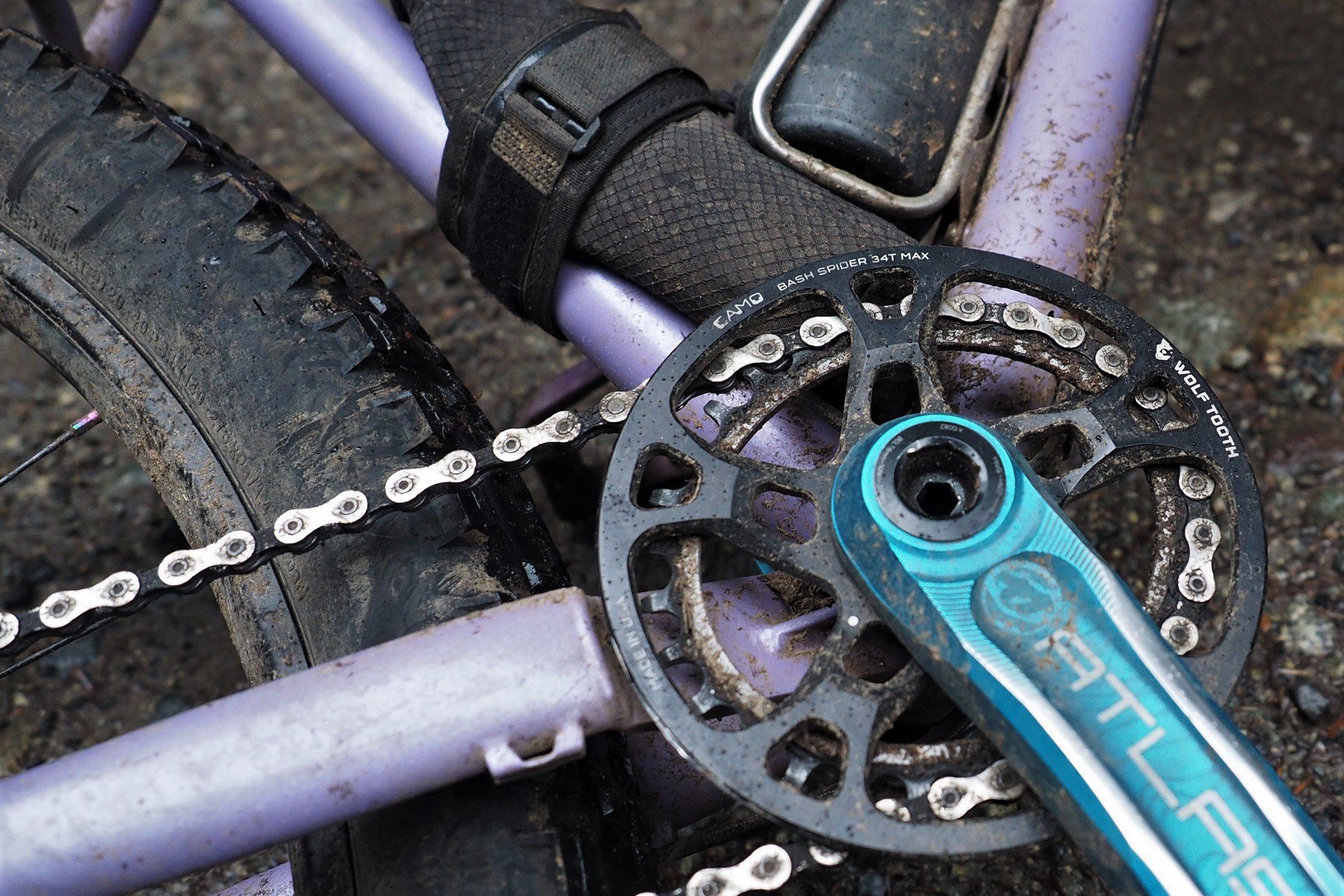
Cinch remains my favourite crank/chainring interface. I love Race Face's philosophy of using existing tools and interfaces for their products even if it means losing out on proprietary tool sales.
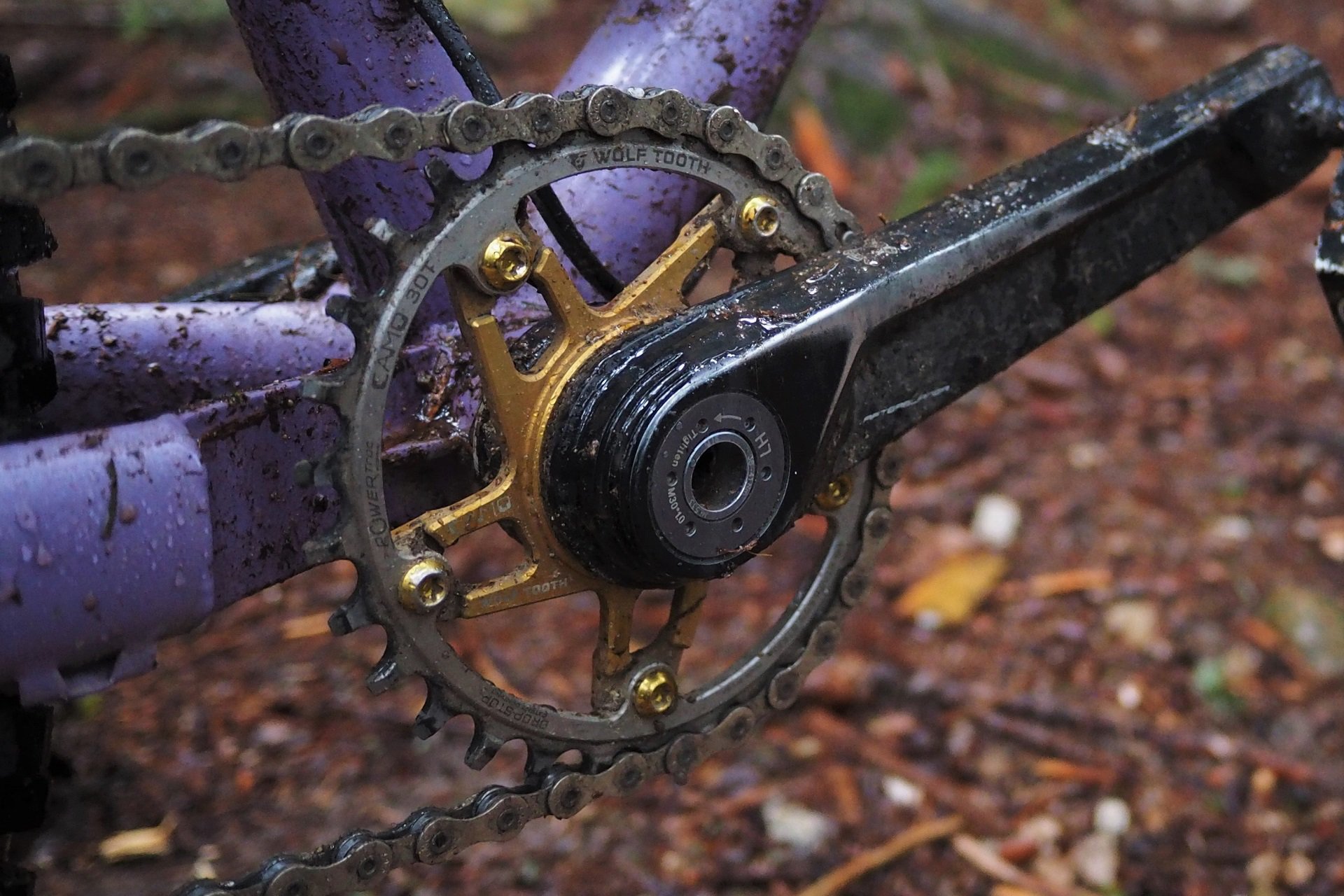
Wolf Tooth is not making a BashSpider for the Cannondale-FSA chainring standard used on these Afterburners. SRAM, Shimano, and Race Face direct-mount standards are supported.
Specific to Wolf Tooth's system, my 30t oval chainring loses a bit of ground clearance running the 34t Camo BashSpider. It's really not enough to be noticeable, or if it is, the smooth bash guard glides and pedals over obstacles much better than my raw chain.
Aesthetically, the system looks much better with my 32t oval chainring but appearance isn't everything. Between CushCore inserts, tough casing tires, and winter conditions, I'm not up for pushing a bigger gear than I'm currently running. If the BashSpider catches on I'd hope that Wolf Tooth would add a smaller option - to cover my 30t oval - but I won't hold my breath. With the advent of 51t and 52t cassette cogs I've talked to more and more riders switching up to 32t, 34t, and occasionally even larger chainrings on their 29ers, with real rubber.
I also suspect we'll see an increasing number of full suspension bikes that cannot physically run a ring smaller than 30 teeth, without the chain sawing at the chainstay. Not to mention companies providing specifications for recommended chainring size as the bikes are ever further optimized.

All the greasy rocks. This bash ring bears graphic witness to all the times I haven't smoked my chain & ring since it was installed. Photo: Deniz Merdano
Put me in the camp that prefers direct-mount crank systems over bolted systems. I also misses bash rings so desperately that I'd gladly go back to them if that was the choice. The more complicated, more fragile, more expensive, more likely to hang-up, ISCG-mounted 'Taco' style bash guards may have helped sound the death knell of cranksets with 4/104 spiders, but as they appear to be falling out of favour it seems like a great time to go full circle.
A Wolf Tooth BashSpider is 60 USD | 82 CAD for a rider who already owns a CAMO chainring or add 50 USD | 70 CAD for an aluminum ring, 100 USD | 140 CAD for a stainless steel ring, and 6 USD | 7 CAD for bolts. It's certainly an investment but the stainless steel rings I've been running have kept on going for so long on my geared bike, single speed, and commuter I think there's a strong value argument for many regular riders, particularly considering how much some aluminum narrow-wide rings cost these days .
On another level, the fact that the Minneapolis-based manufacturer sees this much demand for a bash ring setup has me surprised that we haven't seen anything from Burnaby, BC-based Race Face, or SRAM with their cadres of talented, PNW-based, staffers, riding bikes all the time. Is it a shot in the dark or will 2021 mark the return of the crank-mounted bash ring?

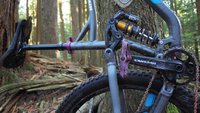

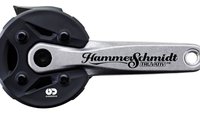
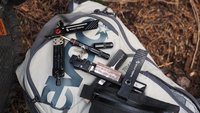






Comments
Allen Lloyd
3 years, 2 months ago
Best bash guard I ever had was shaped like a dull saw blade. It would slide across things, but if you pedaled it would dig into a log and get you over it. Worst one I ever had was a Truvative one that came OEM on a bike, it was too thin and I still remember bending it and my chainring on a ride. Ended up taking it off and throwing it like a frisbee into the woods. Then spent 5-10 minutes searching for it because my buddy refused to let me leave it in the woods.
Reply
Andrew Major
3 years, 2 months ago
I never noticed a benefit to the saw blade style bash rings but I definitely had friends who swore by them.
That’s awesome of your buddy. Did he heckle you the whole time?! Hahahahahaha
Reply
Allen Lloyd
3 years, 2 months ago
He heckled until I found it and threw it at him.
The saw blade helps with really high downed trees, I loved when people would say "that isn't possible!" then I would smash the ring into the tree give it a quick ratchet and hop off the other side. Sad thing is it has been years since I encountered a trail that left downed trees as obstacles, it is such a rewarding thing to get over a tree across a trail.
Reply
Andrew Major
3 years, 2 months ago
Some of my favourite trails have pump-up/ pump-over rocks, roots, or logs. Definitely with you.
Reply
Mammal
3 years, 2 months ago
Classic story! Thanks.
Reply
Christopher Daniel
3 years, 2 months ago
That's the QBP Tooth Fairy! I still have one on the old 2003 Rocky Vertex.
Reply
Ryan Walters
3 years, 2 months ago
I am 100% on the ring mounted bash program. For all the obvious reasons stated above. I catch a bit of flack for my “old-school” setup, but I’m the one laughing with a drivetrain that doesn’t need monthly chain and ring replacements.
I was tempted to pull the trigger on the WT Camo system for my new build, but HATE the idea of needing to stick to WT proprietary rings. Managed to build up the perfect system for cheap - an older SRAM spider, 104 30t ring and RaceFace bash. It even allowed me to run the Spesh top guide as shown in picture (which I’ve since removed, as I think it’s overkill).
Reply
Andrew Major
3 years, 2 months ago
I generally, genuinely, dislike anything proprietary but CAMO is such a great system I can get over it.
I have a friend that did the same as you with a Cinch spider (104 ring / bash). It works great and he had the bash and got the slider for nothing so that was a min-max win for sure.
Reply
Vik Banerjee
3 years, 2 months ago
I love me an ISCG taco bashguard. One of my only regrets on my custom frame was forgetting to request those tabs. Luckily MRP makes an adapter. I hit my taco bash every ride so it's well worth it. I'm glad there are crank mounted bashguards for frames without ISCG tabs and without a threaded BB [I'm looking at you Chromag!], but that would be my third choice after tabs or a BB mounted ISCG adapter.
Reply
Andrew Major
3 years, 2 months ago
Curious what you prefer about a bash taco? Doesn’t crank over things as nicely, more likely to get hung up, puts load into frame instead of cranks (I guess the adapter version is actually sheer loading the BB?).
I’m actually in the nothing is better than an ISCG bash camp for Shore riding. Hence not running one on my Marin. Had a few scary moments dropping into steeper jank where just a chain - or preferably a bash ring - just slide.
Reply
Stephen Gaucher
3 years, 2 months ago
The bash ring is shear-loading the whole crank. I'd be worried about damage to the spindle or BB bearings.
Reply
IslandLife
3 years, 2 months ago
I use a the normal tab attached bash guide but what he's saying is... isn't it better to ruin a crank or BB than a frame? Which I get...
Reply
Andrew Major
3 years, 2 months ago
Also this. Would certainly rather write-off cranks than a frame.
But honestly, taking this Atlas crank as an example - 30mm spindle, big BSA bearings, Cinch interface, 7050-series aluminum crank arms - I’m betting on a long happy life of bash ringing about. Just replacing the BB when it wears out.
Reply
Andrew Major
3 years, 2 months ago
Anecdotally, over two decades working at / with / around shops I’ve only seen a few broken crank spiders from contact with the bash ring, but I’ve seen plenty of ISCG tab failures not to mention broken bash tacos.
Reply
dirtreynolds
3 years, 2 months ago
I've hit ISCG bashguards hard enough to reach failure, but it has always been on the mounting plate itself, never the frame tabs. Then again, I tend to gravitate towards heavier, sturdier, more purpose-built frames. Are frame makers going the 'mostly decorative' route with their ISCG tabs?
I appreciate the review. I've been looking at this Wolf Tooth option for my hardtail, which has no other means by which to attach a bash guard.
Reply
Martn
3 years, 2 months ago
Actually the ISCG-bash should be putting more load into the spindle and the bearings. Your body weight is the load and it's always coming through the pedals. To transfer this load to the ISCG tabs it needs to go through the spindle and bb. To transfer the load to a crank-mounted bash ring on the other hand it only needs to go through the crank (and some part through the spindle, from the left crank).
Reply
Vik Banerjee
3 years, 2 months ago
The taco bash tucks away nicely out of sight, but does its job as needed. I do not get hung up on my taco bashguards. Most are made with plastic that seems to glide well. I do have one metal one and that one doesn't hang up either. I have never damaged a taco bash, ISBG tab, the frame it's attached to or an adapter over years of use.
I don't see any downsides for ISCG mounted tacos from my own experience.
I had ring mounted bashguards in the distant past before ISCG tabs were a thing and we were still running derailleurs. They worked fine, but nothing about them makes me want to get one now unless I happen to have a frame without ISCG mounts or a threaded BB.
Reply
Velocipedestrian
3 years, 2 months ago
Keith Scott (Banshee designer) commented on some emptybeer forum that the ISCG tabs on their gen 2 bikes are designed for guides, not impacts, and suggested going crank mounted bash.
So I did. I preferred the ability to clean the chainring when using a taco, but saw no other upside vs crank mount.
Reply
Andrew Major
3 years, 2 months ago
Was just playing with a Banshee ISCG mount today. If I had to bet (haven’t asked) I’d say the removable ISCG mount is designed to fail without wrecking the frame.
Same idea as Vic’s BB mounted ISCG tab. In theory if he hits the Taco hard it will rotate instead of damaging frame mounts.
Reply
Velocipedestrian
3 years, 2 months ago
Mine is from prior to the removable mount, that came with the updated tubeset version of gen 2. Still not sufficient argument to get me off crank mounted.
Andrew Major
3 years, 2 months ago
As always, every rider’s experiences will vary. I can only speak to my experiences and what I’ve seen in shops.
Reply
Andy Eunson
3 years, 2 months ago
Wait what? Slam a pedal, crank or ring with a bash guard or taco and the forces go into the frame. Even with ISCG tabs. Agreed though tabs are not that skookum and I’ve heard of them failing. A bash ring will also help retain the chain from falling out but not in. Half a small upper guide would complete the chain retention though.
Bash rings will hang up too. Unless you pedal when you strike you will hang up pretty much the same way. And plastic should slide better than aluminum just like with pedals. But of course a bash ring will “pedal off” a rock or log better than a taco bash because you don’t have to wait for the pedal to engage with the rock or wood.
Reply
Velocipedestrian
3 years, 2 months ago
I'm using one up top guide I've given the dremel just as you describe to clear my 4/104 plastic bash (e13). Plenty of scuffs on both suggest they're doing something, while no chain contact under normal use means no drag.
Reply
Andrew Major
3 years, 2 months ago
Andy, I mean, obviously impacting any component transfers some kind or force into the frame.
The point is, as you note, an ISCG mounted bash taco transfers forces different that a crank mounted bash ring and I think most folks working on bikes would agree they’ve seen more broken ISCG tabs than crank spiders.
Looking at the original ISCG chain guides which all combined crank mounted bash rings with ISCG mounted rollers I’d say this is an original truth that was lost at some point.
Reply
Metacomet
3 years, 2 months ago
Exactly. I think the trend towards bash guards on the ISCG tabs started showing up at the same time as the trend towards direct mount single chainrings. Riders probably began noticing they still needed Some sort of bash guard after wasting their chainrings over and over, so this was the most obvious solution, but maybe not necessarily the best solution since the original intent of these tabs was more for chain guides. The best solution would be some sort of true frame mounted bash guard/shield that spans the width of the BB and extends up the downtube a ways, as well as a bash ring, just like on a trials bike, but I think we would probably all agree that would be overkill on anything But a trials bike or something being used as such. My DH bike has an ISCG mounted bash guard and chain guide, but those tabs look WAY more sturdy than anything I've seen on a trail bike. I've also honestly never found myself impacting it as frequently and directly as the bash rings on my trail bikes just due to the nature of the way the bikes are ridden.
Reply
Andrew Major
3 years, 2 months ago
I’d blame the weight weenie DH game that was going on about a decade ago. Flow rims, light hubs, alloy nipples, carbon bars, carbon seat posts, XC cranks with 83mm axles pressed in (or XTR with the preloader removed to fit an 83 shell) - Gamut had maybe the lightest full bash ring chain guide?
Bash Taco with the lower roller integrated with the bash, switch to alloy c/r bolts... that’s dropping grams... hahahaha
Chad K
3 years, 2 months ago
@Andy - I agree about the "hanging up" issue. I personally find that if I am hitting my bash guard, it's usually in a move that is more likely followed up by a "hop," rather than continuing pedaling to get over something.
Reply
Tjaard Breeuwer
3 years, 2 months ago
On one bike, running 1x10, I used a Wolftooth direct mount single ring, with bash guard mounted to it. That was made quite a few years ago, not sure if they still have it. It was a special bashguard, that mounted to spectate holes on the chainring.
The benefit of bolting the bashguard onto the chainring instead of the other way around, would seem to be that you can use a steel chainring, for some extra strength, and plastic bashguard for better sliding.
Reply
Andrew Major
3 years, 2 months ago
I never had good luck with plastic bash guards in the past, but my experiences with plastic pedals have been excellent BSP maybe the newer materials are that much better?
Reply
Tehllama42
3 years, 2 months ago
I guess it just goes to show what a talentless hack I am that I'm so happy with my ISCG mounted bash guide.
Well used, very loved.
Reply
Andrew Major
3 years, 2 months ago
Or maybe just that talented that you’ve had no issues?!
Kidding, I know plenty of riders who swear by a bash taco. To each, their own.
Reply
Tehllama42
3 years, 2 months ago
I think it's unique to trail bikes, that where I ride that stupid thing manages to see non-trivial impacts at least once a month, but none of them are of the frame-shattering variety.
I think there is some engineering validity to loading up a couple of threaded inserts that are reinforced to be partially load bearing rather than having a big shear load dumped into the strongest part of the frame via the crankset, but I think either answer practically outlives the cost/headache of replacing chainrings.
For repeated minor hits, I think either one works, and since I wanted a guide primarily and to minimize weight overall with that happening, I still feel like this is the optimal answer for the cost, but finding stuff on sale always plays a role in that.
Reply
Metacomet
3 years, 2 months ago
I Absolutely subscribe to the bashring camp. Was very happy when I saw the CAMO bashspider from wolftooth come out. Once I wear out or destroy the alloy RF chainring on my fatbike, I'll be ordering one along with a 28t stainless chainring. I'd also second the desire for a smaller option for their 28 and 30 tooth chainrings. A smaller one will look much more appropriate next to the smaller rings, and restore a good chunk of ground clearance. My primary FS bike and my hardtail are both running Saint cranks with 104 bcd RF bash rings, and they have seen a Lot of rocks and all kinds of crap over the years and have the scars to prove it. I always cringe and scratch my head when I see friends destroy their unprotected and dainty direct mount chainrings. The lack of bash ring compatibility has been the biggest thing keeping me away from considering any crankset other than Saint.
Reply
Andrew Major
3 years, 2 months ago
I really think 10-51t/52t cassettes will kill the potential demand for a smaller bashspider, so not holding my breath, but yeah - that would be perfect for me.
Reply
JVP
3 years, 2 months ago
I don't get the trend toward running bigger than a 30t on a trail bike, at least for OR>WA>BC>Idaho>Alaska. Unless you live in Bend or are a racer. How often are we spun out in the 10t in a way that even remotely matters? Compare that to the amount of time deep in the pain cave on a not-really-cleanable pitch. The 30t also keeps you a click or two down from your biggest pie plate(s), getting more life out of the cassette.
I single speeded for years, so maybe I'm just weird and have tasted the joy of pumping the shit out of everything on the descents. Admittedly I get bored on flow trails, so maybe that's it. The masses certainly like the easy flow.
Based on the five gazillion people I saw riding Angels Staircase this fall and the hordes on a few other grunty high-country rides, I can't be that much of an outlier. Whistler xc is certainly funnerer with short gearing, same with a few grunts getting to the fun tech in Squamish.
Easy access flow trails and (awesome) dedicated climb trails are making everyone soft. GET UP INTO THE MOUNTAINS, and rock a 30t to make it more pleasant. {{I'm clearly feeling ranty right now... }}
Reply
Andrew Major
3 years, 2 months ago
Road riding to from trails? Honestly, I don’t get the push for bigger pie plates in the back.
Except that running 30x52t you’re going nowhere so might as well have a 32t or 34t on there and widen the usable gear range?
Reply
Pnwpedal
3 years, 2 months ago
Nah, I'm with JVP on this one. Grinding up a 20-30% grade logging road, which is common in WA state, I'm using every bit of my 30t oval ring and 50t dinner plate cog on my cassette. And on the descents I rarely, if ever, use the smallest cog. Yeah, I'm on a longer and slacker squishy bike with heavier tires which doesn't help climbing efficiency. But as long as I make it to the top without dying too much the bike is well worth the fun going down. Horses for courses, as they say.
Oh, and there is literally zero chance I would ever road ride to a trail in my region. It's a 30-40 minute drive to get to the closest good trails, and 70-80 minutes for others.
Reply
Andrew Major
3 years, 2 months ago
Yeah, it really depends how much gravel/pavement is in a day and how much you care. I ride to Seymour some times on my 30/22t SS so obviously I don’t mind being spun out.
Wheel size, rotating mass, definitely factors. Personal preference too. I think steep-steep STAs and short cranks really force riders to spin more as well which lends itself to lower gearing / higher cadence.
There’s the kinematics question... where 1x has allowed companies to optimize pedaling characteristics around a certain ring size how far do you stray?
Anyways, as always, to each their own. I’d certainly prefer a tighter spread with a smaller ring.
Metacomet
3 years, 2 months ago
The road is the one place where you might spin out for any amount of time, but even then I am more than happy to just level my feet out and just coast for a ways and enjoy looking around. Its not costing me anything, and I am on my mountain bike after all. I've got 11 speed Sunrace 11-46 on my bikes and not in any rush to change that gearing. 28t on the fatbike and 32t stainless rings on 27.5 wheels, any my low range is plenty good. If I had a 50+ cog out back I'm sure there are times I would use it like everyone else, but there are enough benefits to staying with a 46 tooth that I'm more than content with what I have. The only thing I wish my gearing had is hyperglide+. Imagine for a moment if Shimano re-upped there 11 speed, and even 10 speed groups with better 11-46 or wider range and hyperglide+ and even gear spacing!! I imagine I am not the only person out there that could see why this would be very desirable to a huge chunk of people out there.
Reply
KavuRider
3 years, 2 months ago
I run a 34T oval ring on the front of my Yeti, with a 11-50T Sunrace out back. But I ride to the trails as often as I can out here and I typically run out of gears on the road pretty quickly.
30T? I would be spinning out everywhere. I typically run one down from my 50T when climbing (so, 42 I think?) and that is usually good enough for the majority of my climbing, using the 50T as a bailout gear.
Reply
WalrusRider
3 years, 2 months ago
I just wish CAMO was compatible with my XT cranks. One of these days I'll replace them with something CAMO-compatible so I can use the stainless Wolftooth chainrings and one of these bash rings.
Reply
Andrew Major
3 years, 2 months ago
You can still run a standard four bolt stainless Wolf Tooth ring and a regular metal bash ring?
I know a fair few folks who’ve retired their 4/104 cranks do to clearance with their new Boost frames so there must be a fair few floating around.
I do love the CAMO system - I much prefer it over chainring bolts - but if I had a perfectly good crankset I’d run it rather than replace.
Wolf Tooth is making the system for Shimano’s new direct mount too, for folks that prefer that over Cinch (or have an OE crankset).
Reply
JT
3 years, 2 months ago
The bolt heads on the Camo bash look pretty tall in the pic. Do you spot any potential issues with chainstay clearance?
Reply
Andrew Major
3 years, 2 months ago
Same height exactly as rotor bolts. No, can’t think of any bike that would clear the ring and not the bolts.
Reply
AndrewR
3 years, 2 months ago
No issues even with quite tight tolerances on my Optic (which will eventually benefit from the CAMO bash as the frame designer team decided that they would only build it with two rather than three ISCG mounts so a conventional bash guide cannot be properly secured).
Reply
Fred Phillips
3 years, 2 months ago
I used to run them as much for the chain retention as bashing. Lately I've given my cheap Sram alloy ring and chain some solid high-speed hits, pulling bits of sandstone out from between links, but everything was fine. How many of you have actually KOed a ring or chain lately? also carry a quick link and tool?
Reply
Andrew Major
3 years, 2 months ago
What % of riders KO a ring / chain in a year? Very small. But it happens regularly enough that I think it’s worth protecting the ring/chain investment. Especially because walking home with an easily preventable failure sucks.
Also, when a ring cracks/fails it’s always at exactly the farthest walk point to the car/home. It’s a law of the forest or something?!
Reply
Ryan Walters
3 years, 2 months ago
This.
Reply
cheapondirt
3 years, 2 months ago
Thanks for the inspiration to re-mount my old bash ring and remove or modify the upper chain guide to make it work.
When I put the bike together I prioritized chain retention, but that was based on experiences predating both the clutch derailleur and narrow/wide ring.
Reply
Sean Chee
3 years, 2 months ago
I still have my evil lexan bash ring somewhere. Having inbuilt spiders back in the day made any ring protection suck.
I've been eyeing off crank mounted systems when i inevitably have to go to 12 speed and want to up my ring count.
These look nice. Although I am rarely deep enough in the rocks to strike, i am aware that it only takes one.
Reply
dorkweed
3 years, 2 months ago
Why bother with this? Why not run a 104bcd spider with an appropriately sized bash for your chainring? Avoid the proprietary nonsense and have good chainring availability. I’ve even seen a few half plate bashes if you really want to count grams (and always ride same foot forward).
Reply
Andrew Major
3 years, 2 months ago
Very few bikes come with 4/104 setups these days. It’s basically all SRAM, Shimano, or RaceFace direct mount.
You can still find spiders for SRAM cranks but you may run into frame clearance or chainline issues with Boost/SuperBoost
Personally, I really like the CAMO system as it is (generally not a fan of super-proprietary stuff but it’s a great system and with the stainless rings I have no worries getting stuck out suddenly needing a ring) and this is the best bash option for any cranks I own. The rings mount cleanly on threaded seats and the t-25 5-bolt mounting is very clean.
For most people buying a new mountain bike this year, this is the only compatible crank mounted bash option.
Reply
Andrew Major
3 years, 2 months ago
I ran a half-bash on 4/104 for quite a while. Looking back, I wouldn’t consider it worth the weight savings. Better to distribute loads through the whole crank spider.
I do think BMX-style chainring mounted half-bash systems could have potential given how beefy the bodies of some N/W rings are.
Reply
TomM
3 years, 2 months ago
Add me to the list of people who would like to see Wolf Tooth offer a smaller bash ring for a little more ground clearance. I'm using their Camo bash ring on my Scott Genius because it doesn't have ISCG tabs for a bash guard. I've hit the ring on some rocks that I always cleared with a 30t chain ring. That said it's still a great product.
Reply
Please log in to leave a comment.